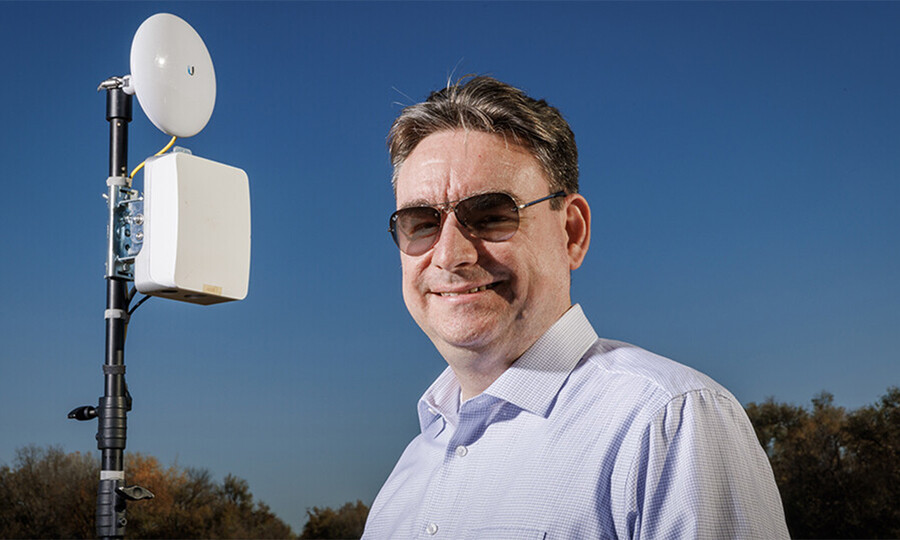
As a young boy growing up in Ankara, the capital of Turkey, Mehmet Can Vuran would disassemble radios for fun to see what was inside and then put them back together.
"We were living very close to the airport, so after playing with the radio, I was able to pick up tower communications," he said. "It was fascinating to hear real-life radio operators on a radio I tinkered with."
Today, Vuran teaches wireless communications and is a renowned computing expert in wireless sensor networks. He is the Dale M. Jensen Chair and Professor of Computing in the University of Nebraska–Lincoln's School of Computing and a fellow of the National Strategic Research Institute at the University of Nebraska. He also directs the UNL Cyber-Physical Networking Lab, which specializes in wireless networks of systems that are aware of their environment and can rapidly adapt to and change that environment.
Vuran’s path to the preeminent reputation he now holds officially began with an undergraduate electrical and electronics engineering degree from Bilkent University in Ankara. He then moved to the United States and completed his master’s and doctorate degrees at the Georgia Institute of Technology before accepting a faculty position at Nebraska in 2007.
"My UNL interview was a really unique experience," he said. "We generally have two days to interview faculty, but the first day was a snow day, so school was closed. I got to see how friendly the department was in accommodating the drastic impact on the schedule, and I got to meet with members of the faculty downtown. That friendly, family-like environment has been everlasting and is one of the reasons I chose to come here."
Strong faculty connections are essential to Vuran’s very interdisciplinary work. He has collaborated on projects to help sensing in next-generation intelligent agricultural networks, reveal hidden safety hazards using workers’ collective behavioral response patterns and improve vehicle-to-barrier communication for crash safety.
His relationships with researchers across UNL that the projects solidify also help him provide his students with unique experiences and the broad education they need to innovate forward in their research and careers.
"To be able to make an impact as a grad student, you have to collect a background in all sorts of areas," he said. "You might have to learn the basics of wireless communications, electrical engineering and programming. I even had students taking classes in both wireless communications and soil science, for example. We collaborate with others in agriculture, civil engineering, construction management, and business, and, with NSRI, now the military as well."
Vuran and a team of graduate students are actively executing development, testing and evaluation for the Department of Defense Naval Surface Warfare Center through a $430,000 grant that was catalyzed by NSRI. The goal of the project is to address highly complex and rapidly evolving challenges for the DOD regarding the use of the electromagnetic spectrum.
"Vuran and his lab are an incredible asset for NSRI that our DOD customers can tap into," said Allen Geist, NSRI director of joint EMS operations programs. "He and his team have been doing incredible EMSO work and really highlight NSRI’s capabilities."
Connecting the needs of national defense with civilian researchers capable of meeting those needs is a core component of NSRI’s mission. stressed the importance of NSRI’s role in allowing this work to happen.
"I want to emphasize the strong, close connection NSRI has with UNL and the University of Nebraska in general," he said. "NSRI’s leaders are very active in terms of meeting with faculty, understanding their strengths and connecting them with problems they can solve. Frankly, these projects wouldn’t be here without that matchmaking."
Much of the work completed by Vuran and his students is conducted outside of the lab, in the field.
"Sometimes if you walk into the CPN lab, it’ll just be dark. No one’s there," he said. "We’re all outside performing underground communications experiments in agricultural fields or collaborating with the UNL Midwest Roadside Safety Facility crashing test vehicles. And our projects have unique experimental aspects you don’t see often in our field."
But no matter the project, seeing students succeed is a primary goal for Vuran. Helping a student who is eager to work on really tough problems launch their doctorate journey and then become an expert who flies all over the world to solve problems — that is the storyline he loves most. CPN Lab’s former graduates now hold prominent positions in Apple, Microsoft, Amazon, Nvidia, Qualcomm, Purdue University and Rice University.
Vuran's reputation, body of work and the students he empowers are a tribute to the boy who built radios decades ago. He is still experimenting and creating every day, fascinated by the results and eager for what’s next.







